
Production tips for top performers: Penstemon
DOWNLOADJune 29, 2008 - Cathy Whitman and Sonali Padhye
Production Tips For Top Performers Penstemon
An American native is regaining its popularity. by CATHY WHITMAN and SONALI PADHYE
PERHAPS it’s human nature to overlook what is nearby or familiar. The roughly 250 species of penstemon are nearly all native to North and Central America, but selections of them became popular in Europe long before American gardeners rediscovered them. Early plant explorers brought their discoveries back to Europe and hundreds of varieties were developed in the 1800s. Penstemon are still hot in Europe and about 25 selections have received the Royal Horticultural Society Award of Garden Merit in recent years. They are gaining in popularity in the United States because of a growing interest in native plants, especially those that attract wildlife and are drought tolerant. Penstemon digitalis ‘Husker Red’ was named perennial plant of the year in 1996 by the Perennial Plant Association, and P. x mexicale ‘Pike’s Peak Purple’ was named to Colorado’s Plant Select program in 1999.
The botanical name penstemon refers to the five stamens in each flower (Figure 1). They’ve acquired the common name of beard tongue because one of the stamens is hairy. Plants produce tubular flowers of red, pink, white, lavender, purple or blue on upright panicles. They thrive in areas with very good drainage and full sun. Penstemon is an excellent choice for xeriscaping and many are extremely attractive to butterflies and hummingbirds.
Cultivars
The taxonomy of penstemon is very complex, but for horticultural purposes they can be roughly divided into two categories: those native to the arid western regions of our continent and those native to the wetter East. Place of origin has implications for their performance in the garden, and some can be short-lived in the eastern United States. Water-logged soil is a limiting factor, particularly in the winter, and hardiness is affected by drainage as much as by temperature.
In the Floriculture Research Program at Michigan State University, we have worked with three species that are native to arid regions. Penstemon barbatus ‘Elfin Pink’ is native to the desert southwest, hardy to Zone 4 and more tolerant of conditions in the East than others in this group. Penstemon x mexicale ‘Pike’s Peak Purple’ and ‘Sunburst Ruby’ are hybrids of Mexican and American species and are hardy to Zone 5. Penstemon hartwegii ‘Pyramid Peak Red & White,’ a tender perennial, is native to central Mexico.
Our trials have included two species that are native to eastern regions. P. smallii is native to the southeastern U.S. and the variety ‘Violet Dusk’ (Figure 2) is hardy to Zone 5. The native range of P. digitalis encompasses the entire eastern U.S. and ‘Husker Red’, a selection from the University of Nebraska, is hardy to Zone 4.
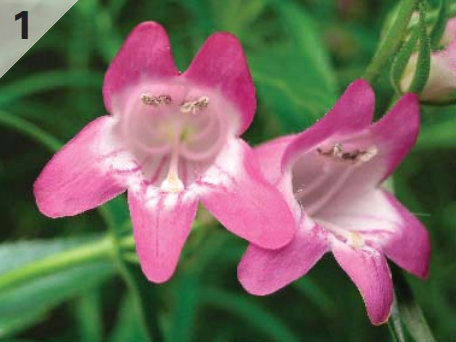
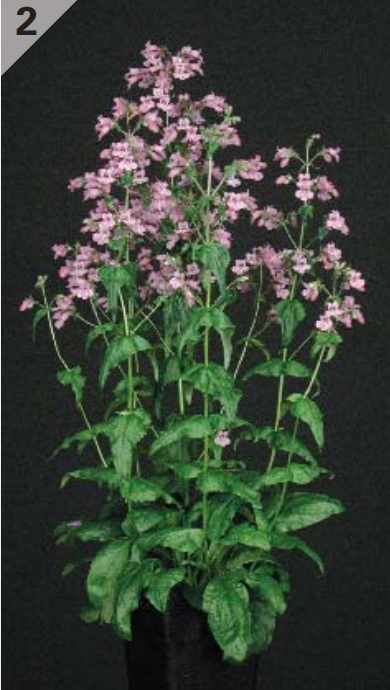
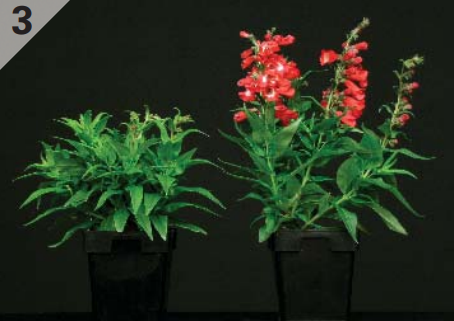
Treatments
Exposure to cold temperatures (vernalization) and photoperiod are two factors that control flowering in many herbaceous perennials. Penstemon plugs were given cold treatments in a cooler set at 41˚F, lighted by fluorescent lamps for nine hours per day. Plants were then grown in our greenhouses under one of three photoperiods: nine-hour short days, 16-hour long days or 16-hour long days with supplemental light.
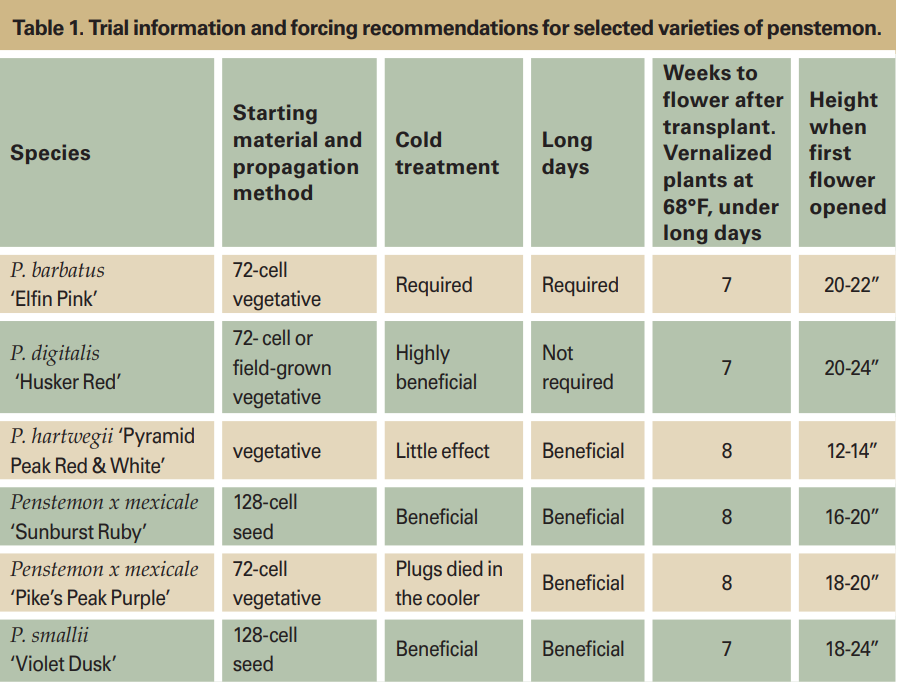
Results
Despite their different backgrounds and origins, all these varieties performed well in our experiments. Only one variety we’ve trialed, ‘Elfin Pink,’ required cold for flowering. The flowering percentage of ‘Husker Red’ was significantly improved by cold treatments. For all others, non-cooled plants flowered readily and vernalization increased flowering percentage slightly. Under our conditions, cold treatments reduced time to flower by two or more weeks on most varieties.
Nearly all varieties tolerated cold storage very well, but many plugs of ‘Pike’s Peak Purple’ died after eight weeks in the cooler. It is important to keep plugs on the dry side during cold treatments and avoid water-logged media.
One variety, ‘Elfin Pink,’ required long days to flower. Flowering of vernalized ‘Husker Red’ plants was not affected by photoperiod. For all others, providing long days hastened flowering by two to four weeks compared to short days (Figure 3). It is important to note that our short days are only nine hours long, considerably shorter than photoperiods generally used during commercial production.
For all these penstemon, average time to flower at 68˚F for vernalized plants was about six to eight weeks after transplant, under long-day photoperiods. See Table 1 for detailed information.
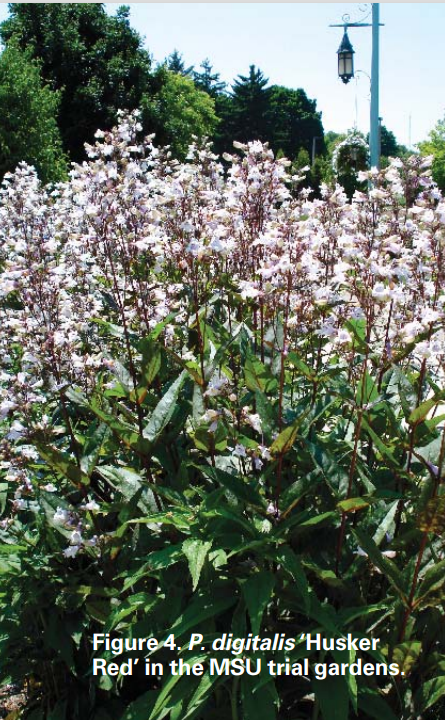
Production Notes
Plant height when the first flowers opened was between 14 and 24 inches for these varieties. Foliar spray applications of ancymidol (A-Rest), paclobutrazol (Bonzi, Piccolo or Paczol) or uniconazole (Sumagic or Concise) were effective for controlling stem elongation on ‘Husker Red.’ Uniconazole has also been effective on ‘Violet Dusk’ and ‘Pike’s Peak Purple,’ and we anticipate that other penstemon may respond similarly. There was a two-week delay in flowering when multiple spray applications of uniconazole were made to ‘Husker Red.
In our trials, supplemental light from high-pressure sodium lamps increased flowering percentage in noncooled plants, and plants were more robust and produced more flowers. All these penstemon performed well in our standard commercial peat-perlite medium. Avoid media that do not provide excellent drainage.
Conclusion
For maximum customer satisfaction, choose species that are suitable for their intended locales, but remember that living things are somewhat adaptable. Microclimates and soil amendments make each garden unique. We have grown both ‘Pike’s Peak Purple’ and ‘Husker Red’ in our trial gardens, which are fairly low-lying and quite moist. Both varieties were relatively short-lived but lovely (Figure 4). New cultivars are continually being introduced, so maybe it’s time to rediscover this great all-American genus!



 Print
Print Email
Email




